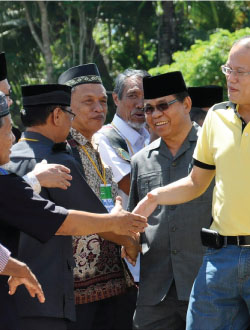Positive Signs for a Southern Philippine Peace

 The Framework Agreement on the Bangsamoro could soon bring a Nobel Peace Prize to the Malaysian prime minister
The Framework Agreement on the Bangsamoro could soon bring a Nobel Peace Prize to the Malaysian prime minister
The intrusion of some 200 Filipino gunmen into Sabah, East Malaysia this past February rekindled a dormant territorial dispute between Manila and Kuala Lumpur over the North Borneo territory. The incursion, which led to a series of armed clashes between the ‘Royal Sulu Army’ and Malaysian security forces, raised concerns over its impact on the Malaysia-brokered Philippine-Moro Islamic Liberation Front (MILF) peace negotiations – specifically, that it might delay the signing of a final agreement. Notwithstanding what has been dubbed the Lahad Datu incident, there are positive indications that the Malaysia-brokered talks between Manila and the MILF remain on track, and that a successful conclusion remains in sight.
The signing of a Framework Agreement on the Bangsamoro on October 15th, 2012 had been hailed as a milestone in relations between the Philippines and the MILF – a Muslim rebel group that has been waging armed insurgency in the southern Philippine island of Mindanao since its formation in 1977. (The Bangsamoro is a new autonomous political region intended to replace the Autonomous Region of Muslim Mindanao.) Nevertheless, given the string of failed agreements between the Philippine government and various Mindanao-based rebel movements, including the Tripoli Agreement of 1976, the Final Peace Agreement of 1996, the Agreement on the General Cessation of Hostilities of 1997, the Tripoli Agreement of 2001, and the Memorandum of Agreement on Ancestral Domain of 2008, what reasons are there to believe that the most recent Framework Agreement will not meet the same fate?
To be sure, there are reasons to be skeptical: all of these earlier agreements were signed with the same hope that we see in Mindanao today; all ended in despair as conflict resumed. Having said this, the Sabah (Lahad Datu) incident is no deal-breaker: at worst, it is tangential to the Manila-MILF peace process. More importantly, though, three important factors are at play today where they were previously absent. Combined, these factors are cause for cautious optimism.
First, there is a strong measure of political will today in both camps. The signing of the Framework Agreement was presaged by the report from the Philippines’ Office of the Presidential Adviser on the Peace Process to the effect that there were no armed clashes between the MILF and the Philippine Armed Forces in the buildup to the agreement. This may have simply been a result of war weariness. After all, the Bangsamoro people and the Philippine government have been fighting each other since the late 1960s. Still, the reality on the ground suggests that there has been greater restraint exercised by both sides. Senior military commanders have pointed out that the MILF headquarters, Camp Darapanan, are well within range of artillery and strike aircraft based at the 6th Infantry Division camp in Cotabato City. Had the Philippine Armed Forces chosen to use force, Camp Darapanan could easily have been crushed. Likewise, whereas MILF forces had previously been reluctant to step aside when government forces conducted operations against other lawless elements in MILF territory, this has not been the case of late; in some cases, MILF forces have even supported such operations.
This restraint is not limited solely to combatants. Other stakeholders with the wherewithal to stymie the peace process have also demonstrated support. A case in point is former Filipino Vice Governor Manny Pinol, who has surprisingly expressed support for the Framework Agreement. (Pinol was once a vocal critic of concessions to the MILF. In 2008, he went so far as to call on Christians in Mindanao to take up arms against Muslim rebels.)
Second, international actors have played a more sustained and positive role than in the past. Local community-level peace initiatives have been given a tremendous boost by the Malaysia-led International Monitoring Team (IMT). When it began in 2004, Malaysian facilitation of the peace process leading to the Framework Agreement was viewed with suspicion in many quarters in the Philippines. The prevailing view was that Malaysia’s involvement was driven primarily by its interest to suppress any prospect of a revival of the Philippine claim to the East Malaysian state of Sabah, which Manila has yet to officially disavow. According to this interpretation, the objective of Malaysian facilitation was not to resolve the conflict, but rather to prolong it. Hence, in order to bolster its credibility, Malaysia could not be seen as the sole international actor in the mediation process. In fact, in spite of Lahad Datu, both Manila and the MILF have been adamant in pointing out that “Sabah is not part of the agenda[,]” and that Malaysia’s facilitation has been an “institution” in the negotiations.
In 2008, the outbreak of violence in Central Mindanao between MILF hardliners and government forces once again called into question Malaysian-led mediation. In response, the International Contact Group (ICG) was formed in 2009. Comprising representation from Britain, Japan, Turkey, Saudi Arabia, as well as NGOs like the Asia Foundation and the Geneva-based Centre for Humanitarian Dialogue (among others), the ICG managed to restart stalled talks between the two contending parties. The new series of talks culminated in a ‘secret meeting’ between Filipino President Benigno Aquino III and MILF Chairman Murad Ibrahim in Tokyo in July 2011. After this meeting, dialogue gathered pace, resulting in the signing of the Framework Agreement.
The internationalization of negotiations dispelled any suspicions that the peace talks were opaque and controlled by Malaysia. There followed, in early 2012, the deployment of an Indonesian military contingent and ceasefire monitors to bolster the IMT – thereby contributing further to the legitimacy of the mediation effort.
Third, and perhaps most critical, the Framework Agreement offers prospects for a reduction in income inequality and levels of relative deprivation in Mindanao. While peace must come via a political solution, it can only be sustained through tangible economic and material improvements. And the Framework Agreement portends future economic prosperity for the region.
As early as 2005, the UN Development Program’s Philippine Human Development Report identified economic factors as the main driver of conflict and violence in Mindanao. The problems currently encountered by the Autonomous Region in Muslim Mindanao, which was formed out of the 1996 Final Peace Agreement, clearly show that the absence of significant improvements in quality of life has made communities and individuals vulnerable to extremism and violence.
Mindanao’s economic potential is undeniable. The region is a natural draw for industries such as power generation and large-scale agriculture. Already, Malaysia’s Felda Global Ventures, the world’s largest producer of crude palm oil, has expressed interest in investing in Mindanao with an eye to converting the estimated one million hectares of otherwise fallow grassland to palm oil plantations. Further out from Central Mindanao, the areas of Liguasan Marsh, the Cotabato Basin, and the Sulu Sea – all part of the prospective Bangsamoro lands to be defined under the Annexes to the Framework Agreement – are potentially energy-rich areas that have elicited attention from international oil companies.
Econometric studies by the National Economic and Development Authority (NEDA) have concluded that Mindanao can “grow much faster than Luzon” if armed conflict with the MILF can be resolved. These studies further highlight that development of Mindanao can be accelerated through strategic use of the region’s human capital and the development of a tourism industry. Similar points have been made by the World Bank, which has identified the youthful urban demographics of regional centres around Central Mindanao – Cagayan de Oro and Davao, in particular – as potential hubs for technology and business process outsourcing startups.
There is no doubt that immense challenges lie ahead for Mindanao. For starters, the Framework Agreement is not yet a complete document. As of April 2013, only one annex – on “Transitional Arrangements and Modalities” – had been completed. The more critical annexes on power sharing, wealth sharing and normalization remain incomplete. Philippine panel head Miriam Coronel Ferrer projects that by the end of 2013, a Final Peace Agreement will be inked, and that the Basic Law will be completed and approved in a 2014 plebiscite. Only this can pave the way for the creation of the Bangsamoro Transition Authority that would provide Filipino Muslims with meaningful autonomy by 2015.
The institutionalization of the newly conceptualized relationship between the Philippine government and the new Bangsamoro political entity may take several more years. Given that rogue elements of the MILF have rejected the Framework Agreement, there is also the possibility of a return to conflict. Nevertheless, for the aforementioned reasons, the Framework Agreement provides a firm basis for development, political participation and empowerment for the Bangsamoro people of Mindanao in ways that previous agreements did not. The fruits of peace in Mindanao are now there to be harvested. With the Framework Agreement in place and a Transition Commission already convened, perhaps the actors concerned finally have the right tools in their hands to do the job.
Joseph Chinyong Liow is Professor of Comparative and International Politics at the S. Rajaratnam School of International Studies, Nanyang Technological University (Singapore).
Joseph Franco is Associate Research Fellow at the S. Rajaratnam School of International Studies, Nanyang Technological University (Singapore).











